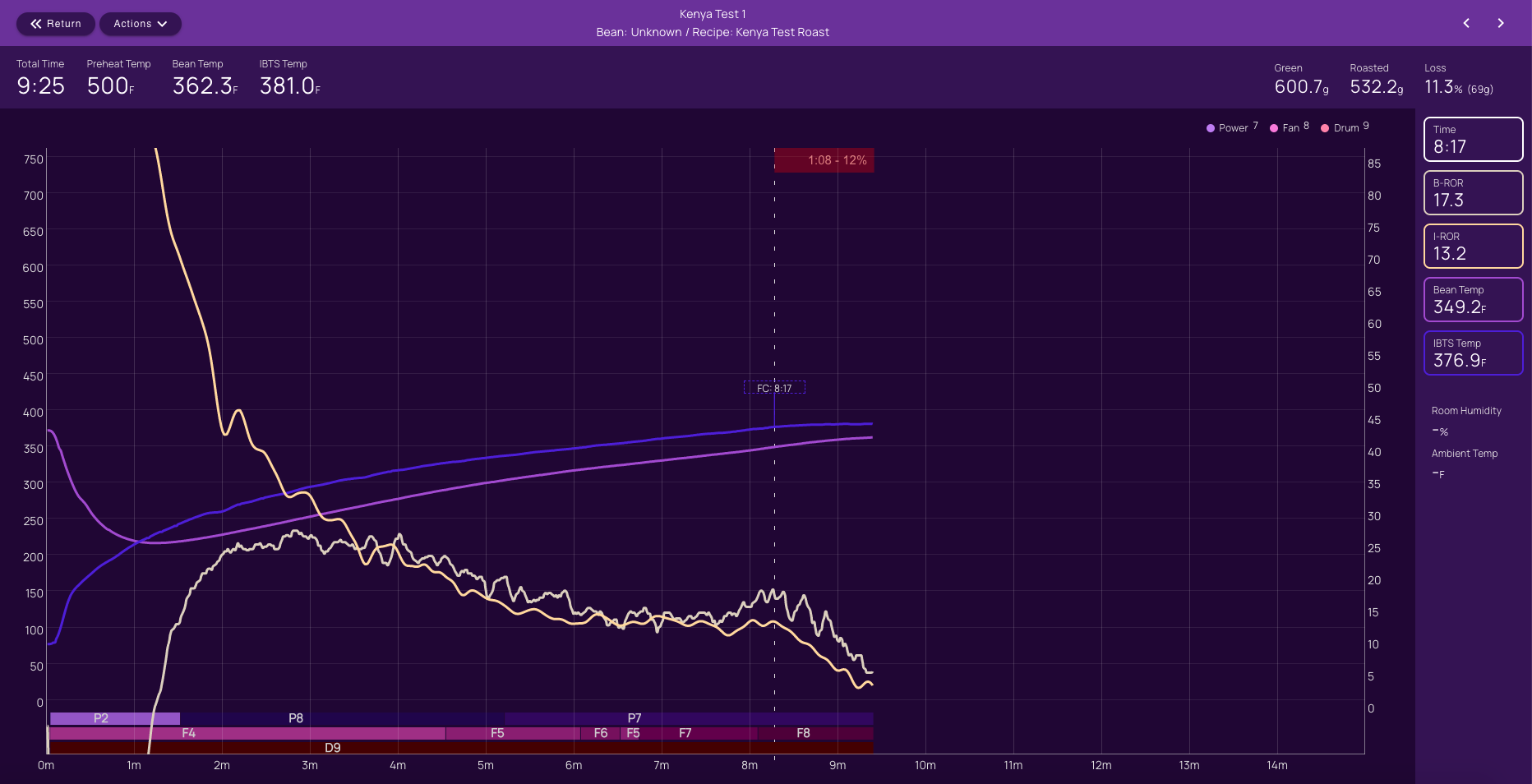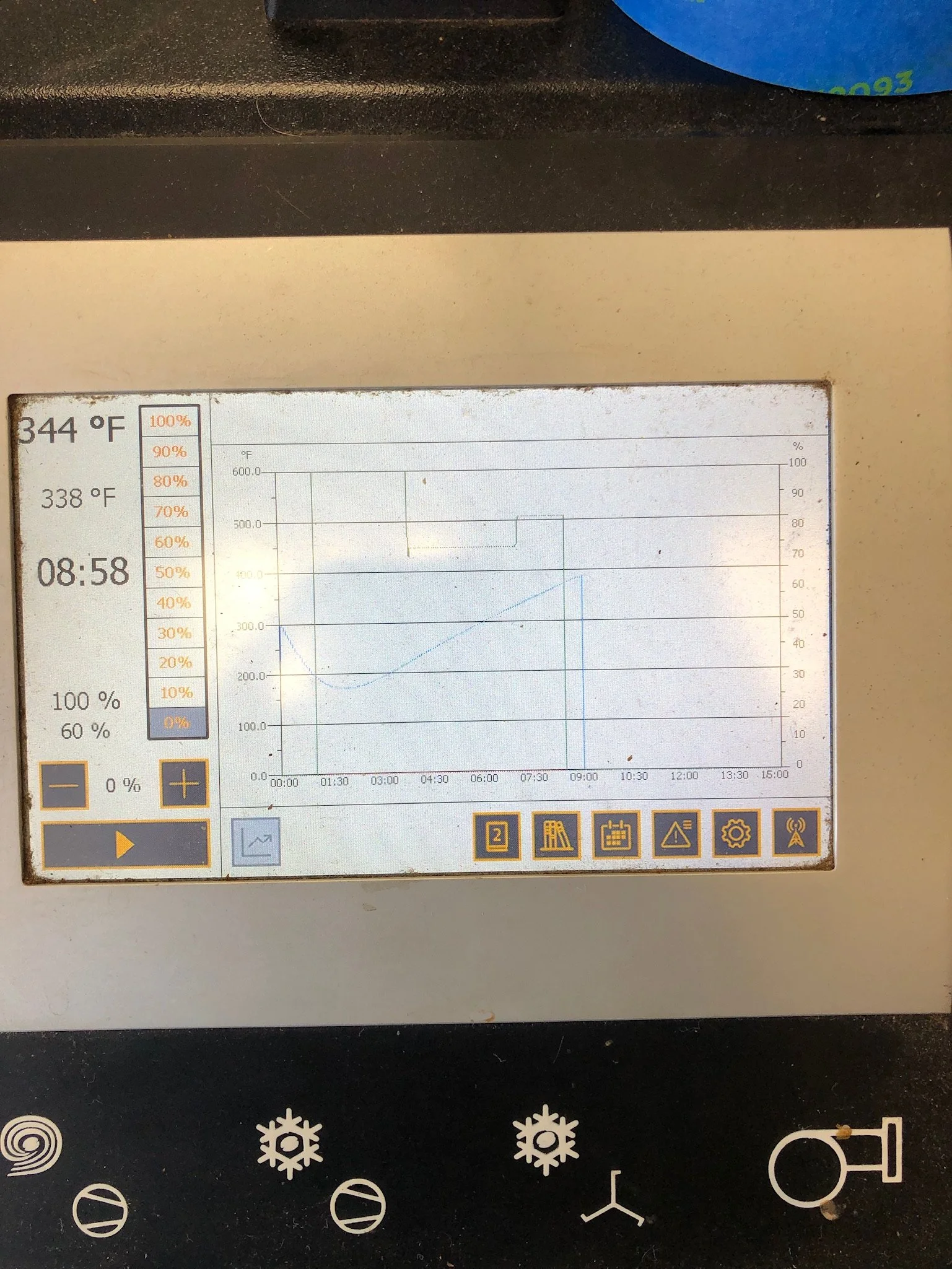This coffee has been a breeze to roast compared to our last Ethiopian Lemon Candy release! The AA screen size and limited varieties (Mostly SL28 and SL34 with only a little Ruiru varieties) gave us flexibility with a wider sweet-spot range for first crack development and final drop temperatures. We’d be interested to know how the processing at origin effected this wide sweet spot range as well. Our Importers, Catalyst Trade are known for their phenomenal quality control and going above and beyond with innovative sorting/separating methods at origin. Also, the lower Kenyan altitude of 1,550-1,600 MASL may have helped with this as well, and quite possibly the age of the green.
The thing that stumped us at first is how quickly these beans reached first crack! It reached first crack at much colder temperatures than our previous releases, and we were very surprised when we heard it popping. We accomodated to this in the first 600g batch (V1) by just prolonging the post first crack development time. We then began our 2nd roast with keeping everything the same but dropping the beans with a shorter post first crack development around 0:30 seconds. This was way too light and tasted like honey, without any complexity or “wanted” acidic traits.
One of our favorite roasts from our first test day of V1-V4 was V4. As you can see below, we chose to roast much faster by increasing the charge temperature of the roaster from 500 degrees to 527 degrees. We also chose to roast with slightly less fan speed to bring the beans up to temp very quickly. This roast tasted phenomenal, though it was showing some signs of that underdeveloped honey note which is all too common with this roaster (nothing grassy or vegetal, just sweet honey, which isn’t a bad thing!). It had many desired acidic traits, but we wanted to reduce that (slightly) underdeveloped honey note/sweetness.
The next week we roasted a few more batches that revolved around lowering the charge temp of the roaster again back to 500 degrees, and changing the fan speed at the later end of mallard development which was about 1 minute before first crack for this new batch of roasts. This obviously extended the roast which gave us more development time to allow for a faster post first crack development time of 0:09 seconds faster post first crack development in our new favorite roast (V6) compared to the previous roast.
What’s really interesting is our original favorite roast (V4) has the same weight loss development as our final and favorite profile (V6). V6 doesn’t have that underdeveloped honey taste and represents the vibrant effervescent acidity we were aiming for! We could have just extended post first crack development but I believe if your post fc dev time is faster, you can have more acidity and brighter flavors if you roasted longer, but with a shorter post first crack development time. Personally, I don’t ever want to roast filter coffee on this specific roaster that goes over 1:00 of post first crack development time. It’s a personal limit i’ve put on myself to go against this crazy-long post first crack development time we see all the time in America’s “light” roast profiles. If i need to go over that 1:00, I will, but i believe i can always change up my approach to be under 1:00, always. We shall see!
Translating to the Probat
We have been partnering with a local roaster to use their Probatino 12 Kilo machine. Lesa, the owner, has seen a lot of success through decades of experience in the coffee industry and roasting. It has been a blessing learning from her and communicating ideas for how to translate our chosen Aillio Bullet roast profile to a completely different machine. Which is partially why it took us only 4 roasts to pick the final profile (and the last 3 were extremely close!).
Our first roast on the Probat, again, skyrocketed and turned out overdeveloped. It was a very different flavor experience with this coffee, showcasing grapefruit zest, organge/pink citrus fruits, but with a burgundy-like wine note that was a bit dry and smokey. It smelled wonderful, like a pomegranate fruit juice cocktail! It definitely had a jammier body.
The second batch we dropped the charge temperature by 12 degrees. The roast was much lighter with about the same post first crack development time, and a lower drop temperature. It had that grapefruit zest acidic note with a wonderful pomegranate candy sweetness. It also had pops or acidity but it still showcased a slight bitter note that was blocking clarity.
Comparing these two Probat roasts on the bullet, the clarity is truly unmatched. We are simply not used to tasting coffee with this much clarity from any roaster. Maybe a Loring roaster with a similar first crack development time like what Tim Wendelboe is known for, but this kind of clarity is extremely hard to find in our opinion.
For the next Probat roasts (batch 3 & 4), we actually lowered the batch size from 17 to 15 pounds to have a higher drum retaining temperature. This is a GENIUS call by Lesa because 12 degrees hotter started to tip the coffee, and we were already running heat near the highest capacity of the Probat (a disadvantage). I know it can take many experienced roasters a very long time to develop their understanding of this concept of thermal energy in roasting, instead of just associating it with heat and a number. Luckily, because of her experience, this fixed our issue right away!
We were able to get a nice development, while being able to drop the coffee at a much lower first crack development time! This roast is very light, tastes clean and clear, plus you get the trademark Probat sweetness and body!
What a ride this has been! We hope you enjoy this roast and look at the details of our profiles below to try and either replicate them yourself, or think about how your favorite roasters develop their profiles.
Maybe they’ll even share them with you!
Final Profile on the Aillio Bullet to translate over to the Probat
V1 - Our first roast
V4 - Precursor to our final roast
Cold Roast Start! This is a fun one! And you know what? It takes EXTREMELY similar to our final roast profile!
yellowing times are very similar to these profiles. This goes to show that the drying stage may not make a big impact on flavor on its own.
*We wanted to see if we could replicate the Nucleus Link sample roaster with a similar profile using a cold disaster.
Here is the Probat profile we are aiming for. The end drop temperature is between 367-370. First crack is at 8:15. Post first crack development is about 0:51 seconds.
Keep in mind we are using bean temperature to guid our variables (slightly) more, unlike the bullet where time essentially guides everything and bean/IBTS temps are secondary.





